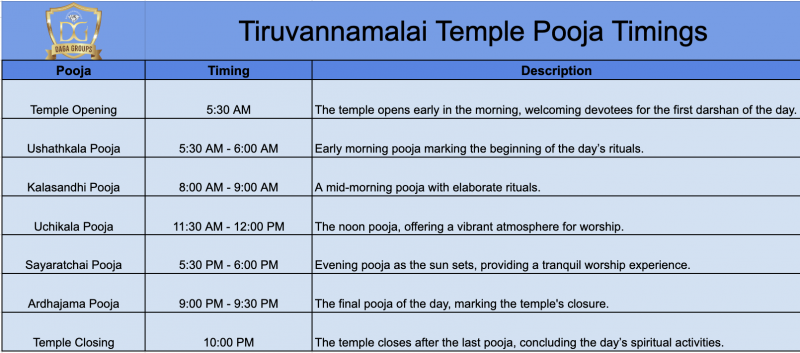- May 30, 2024
-
Essential Guide to Pooja Timings at Tiruvannamalai Temple
The Tiruvannamalai Temple, also known as the Annamalaiyar Temple, is one of the most revered Shiva temples in India. Nestled in the town of Tiruvannamalai in Tamil Nadu, this ancient temple is not only a spiritual hub but also a marvel of Dravidian architecture. To fully immerse yourself in its divine ambience, it's crucial to be aware of the pooja timings. This guide will help you plan your visit and ensure you partake in the temple's sacred rituals.
Overview of the Tiruvannamalai Temple
Before diving into the pooja schedule, let's take a brief look at the temple itself. The Tiruvannamalai Temple is dedicated to Lord Shiva, who is worshipped here as Annamalaiyar or Arunachaleswarar. The temple complex spans over 25 acres, featuring grand gopurams (towers), intricately carved stone walls, and spacious courtyards. The temple's history dates back several centuries, making it a significant pilgrimage site.
Daily Pooja Timings
The temple conducts several poojas throughout the day, each with its unique significance. Here's a breakdown of the daily pooja schedule:
Ushathkala Pooja (Early Morning)
- Timing: 5:30 AM
- Significance: This pooja marks the beginning of the day with the first darshan of Lord Annamalaiyar. It's a serene time to experience the divine presence with fewer crowds.
Kalasandhi Pooja
- Timing: 8:00 AM
- Significance: Performed with elaborate rituals, this pooja is an excellent opportunity for devotees to offer their prayers and seek blessings for a prosperous day.
Uchikala Pooja (Noon Pooja)
- Timing: 12:00 PM
- Significance: The midday pooja is a vibrant and energetic ceremony, attracting a significant number of devotees.
Sayaratchai Pooja (Evening Pooja)
- Timing: 5:30 PM
- Significance: As the sun sets, this pooja offers a tranquil ambience for reflection and prayer.
Ardhajama Pooja (Night Pooja)
- Timing: 9:00 PM
- Significance: The final pooja of the day, marking the conclusion of the daily rituals. It’s a peaceful time for devotees to connect with the divine before the temple closes.
Special Poojas and Festivities
Apart from the daily rituals, the Tiruvannamalai Temple hosts several special poojas and festivals throughout the year. These events draw large crowds and are a spectacle of devotion and tradition.
Karthigai Deepam
- When: November-December
- Highlights: This is the most significant festival of Tiruvannamalai. A massive lamp is lit atop the Annamalai hill, symbolizing the divine light of Shiva. The temple and town are adorned with lamps, creating a mesmerizing sight.
Pradosham Pooja
- When: Twice a month, on the 13th day of each lunar fortnight
- Highlights: Dedicated to Lord Shiva, this pooja is believed to cleanse sins and bestow blessings. The temple witnesses a surge in devotees during Pradosham.
Maha Shivaratri
- When: February-March
- Highlights: Celebrated with grandeur, this night-long festival involves continuous poojas, bhajans, and a special abhishekam (ritual bathing) of the Shiva Lingam.
Tips for Visitors
- Arrive Early: To avoid the rush, especially during festivals, try to arrive at the temple early in the morning.
- Dress Appropriately: Wear traditional and modest clothing as a sign of respect.
- Stay Hydrated: Carry water, especially if you're visiting during the hotter months.
- Plan for Festivities: If you wish to experience the grandeur of the festivals, plan your visit accordingly, but be prepared for large crowds.
Conclusion
Understanding the pooja timings at the Tiruvannamalai Temple can significantly enhance your visit, allowing you to immerse yourself in the spiritual essence of this sacred place. Whether you're seeking the tranquillity of the early morning pooja or the vibrancy of the noon rituals, each moment spent here is a step closer to the divine.



Comments :
Currently, there are no comments in this post. Be the first person to comment on this post.